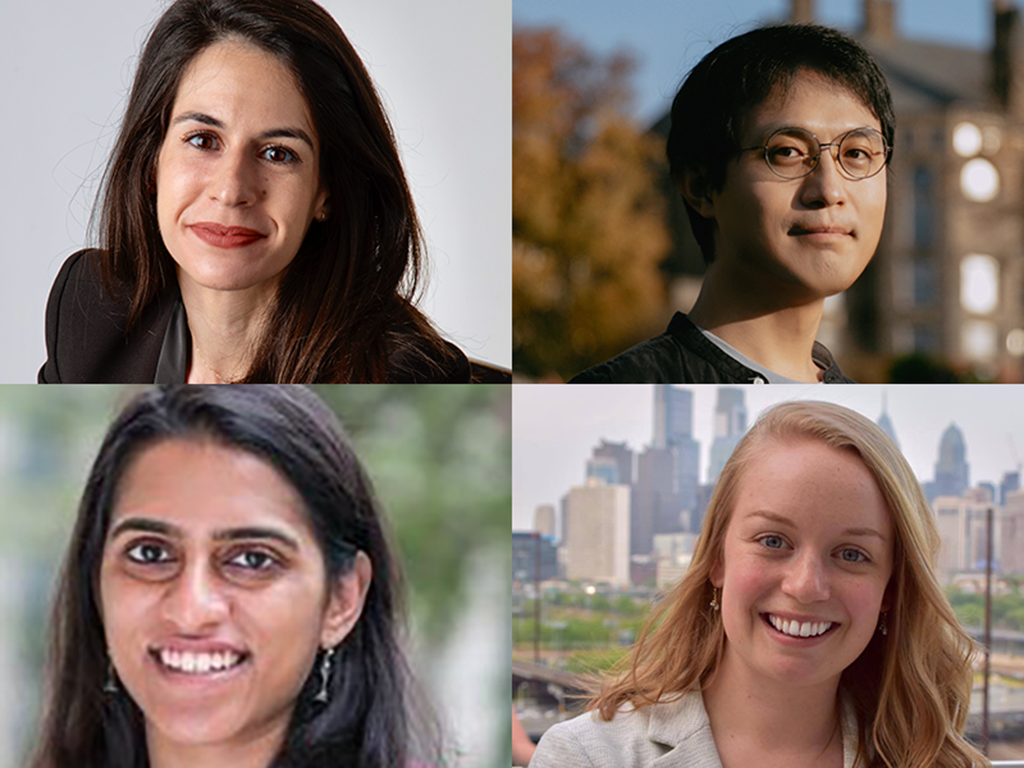Four researchers with MIT ties earn Schmidt Science Fellowships
Four researchers with MIT ties — Juncal Arbelaiz, Xiangkun (Elvis) Cao, Sandya Subramanian, and Heather Zlotnick ’17 — have been honored with competitive Schmidt Science Fellowships.
Created in 2017, the fellows program aims to bring together the world’s brightest minds “to solve society’s toughest challenges.”
The four MIT-affiliated researchers are among 29 Schmidt Science Fellows from around the world who will receive postdoctoral support for either one or two years with an annual stipend of $100,000, along with individualized mentoring and participation in the program’s Global Meeting Series. The fellows will also have opportunities to engage with thought-leaders from science, business, policy, and society. According to the award announcement, the fellows are expected to pursue research that shifts from the focus of their PhDs, to help expand and enhance their futures as scientific leaders.
Juncal Arbelaiz is a PhD candidate in applied mathematics at MIT, who is completing her doctorate this summer. Her doctoral research at MIT is advised by Ali Jadbabaie, the JR East Professor of Engineering and head of the Department of Civil and Environmental Engineering; Anette Hosoi, the Neil and Jane Pappalardo Professor of Mechanical Engineering and associate dean of the School of Engineering; and Bassam Bamieh, professor of mechanical engineering and associate director of the Center for Control, Dynamical Systems, and Computation at the University of California at Santa Barbara. Arbelaiz’s research revolves around the design of optimal decentralized intelligence for spatially-distributed dynamical systems.
“I cannot think of a better way to start my independent scientific career. I feel very excited and grateful for this opportunity,” says Arbelaiz. With her fellowship, she will enlist systems biology to explore how the nervous system encodes and processes sensory information to address future safety-critical artificial intelligence applications. “The Schmidt Science Fellowship will provide me with a unique opportunity to work at the intersection of biological and machine intelligence for two years and will be a steppingstone towards my longer-term objective of becoming a researcher in bio-inspired machine intelligence,” she says.
Xiangkun (Elvis) Cao is currently a postdoc in the lab of T. Alan Hatton, the Ralph Landau Professor in Chemical Engineering, and an Impact Fellow at the MIT Climate and Sustainability Consortium. Cao received his PhD in mechanical engineering from Cornell University in 2021, during which he focused on microscopic precision in the simultaneous delivery of light and fluids by optofluidics, with advances relevant to health and sustainability applications. As a Schmidt Science Fellow, he plans to be co-advised by Hatton on carbon capture, and Ted Sargent, professor of chemistry at Northwestern University, on carbon utilization. Cao is passionate about integrated carbon capture and utilization (CCU) from molecular to process levels, machine learning to inspire smart CCU, and the nexus of technology, business, and policy for CCU.
“The Schmidt Science Fellowship provides the perfect opportunity for me to work across disciplines to study integrated carbon capture and utilization from molecular to process levels,” Cao explains. “My vision is that by integrating carbon capture and utilization, we can concurrently make scientific discoveries and unlock economic opportunities while mitigating global climate change. This way, we can turn our carbon liability into an asset.”
Sandya Subramanian, a 2021 PhD graduate of the Harvard-MIT Program in Health Sciences and Technology (HST) in the area of medical engineering and medical physics, is currently a postdoc at Stanford Data Science. She is focused on the topics of biomedical engineering, statistics, machine learning, neuroscience, and health care. Her research is on developing new technologies and methods to study the interactions between the brain, the autonomic nervous system, and the gut. “I'm extremely honored to receive the Schmidt Science Fellowship and to join the Schmidt community of leaders and scholars,” says Subramanian. “I've heard so much about the fellowship and the fact that it can open doors and give people confidence to pursue challenging or unique paths.”
According to Subramanian, the autonomic nervous system and its interactions with other body systems are poorly understood but thought to be involved in several disorders, such as functional gastrointestinal disorders, Parkinson’s disease, diabetes, migraines, and eating disorders. The goal of her research is to improve our ability to monitor and quantify these physiologic processes. “I'm really interested in understanding how we can use physiological monitoring technologies to inform clinical decision-making, especially around the autonomic nervous system, and I look forward to continuing the work that I've recently started at Stanford as Schmidt Science Fellow,” she says. “A huge thank you to all of the mentors, colleagues, friends, and leaders I had the pleasure of meeting and working with at HST and MIT; I couldn't have done this without everything I learned there.”
Hannah Zlotnick ’17 attended MIT for her undergraduate studies, majoring in biological engineering with a minor in mechanical engineering. At MIT, Zlotnick was a student-athlete on the women's varsity soccer team, a UROP student in Alan Grodzinsky's laboratory, and a member of Pi Beta Phi. For her PhD, Zlotnick attended the University of Pennsylvania, and worked in Robert Mauck's laboratory within the departments of Bioengineering and Orthopaedic Surgery.
Zlotnick’s PhD research focused on harnessing remote forces, such as magnetism or gravity, to enhance engineered cartilage and osteochondral repair both in vitro and in large animal models. Zlotnick now plans to pivot to the field of biofabrication to create tissue models of the knee joint to assess potential therapeutics for osteoarthritis. “I am humbled to be a part of the Schmidt Science Fellows community, and excited to venture into the field of biofabrication,” Zlotnick says. “Hopefully this work uncovers new therapies for patients with inflammatory joint diseases."

